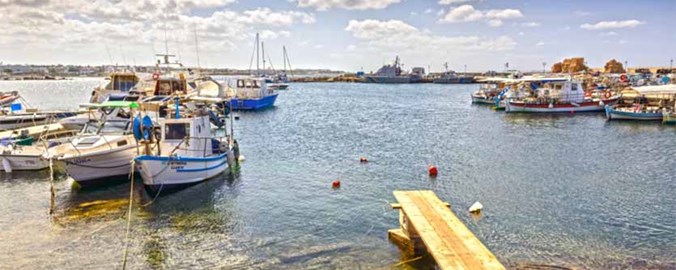
Property in Paphos
Paphos nestles in the lee of the Western Troodos Mountains, which add another dimension to this area of scenic beauty. The recent addition of its own international airport has opened up the Paphos area to mass tourism and the resort is graced with some luxury hotels along the coastline.
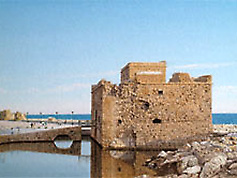 Paphos has an air of holiday charm combined with history and elegance from its classical style buildings in the upper part of town. The lower part of the town - known as Kato Paphos - has a coastal life of its own and here you will find the harbour, the fish tavernas, souvenir shops as well as several beautiful hotels, with important archaeological sites surrounding them.
Paphos has an air of holiday charm combined with history and elegance from its classical style buildings in the upper part of town. The lower part of the town - known as Kato Paphos - has a coastal life of its own and here you will find the harbour, the fish tavernas, souvenir shops as well as several beautiful hotels, with important archaeological sites surrounding them.
A former capital of Cyprus, Paphos has a history dating back thousands of years. Innumerable ancient sites are to be found in the area of Paphos and these are included in UNESCO's list of World Cultural Heritage sites. Paphos became the capital of Cyprus under the successors of Alexander the Great - the Ptolemies and in those days its harbour was a busy, thriving port. It continued as the island's first city for more than seven centuries, retaining its importance under Roman rule. Its most famous Governor, Sergius Paulus, was converted to Christianity by St Paul in 45 AD.
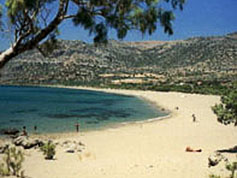 This is the birthplace and centre of worship of Aphrodite, the Goddess of Love and Beauty and the whole area retains some of this magic. Landmarks associated with Aphrodite are the chunky, rugged rocks of her beautiful birth shore known as the Aphrodite Rocks or "Petra tou Romiou", the evocative sanctuary of Aphrodite at Kouklia Village, one-time shrine and scene of pagan festivals for thousands, the Baths of Aphrodite at Polis, supposed source of fertility and the Fountain of Love, or Fontana Amorosa, a few miles further into the Akamas Peninsula. Even the town's name is linked to the Goddess as Paphos was the name of the mythological daughter of Venus and Pygmalion.
This is the birthplace and centre of worship of Aphrodite, the Goddess of Love and Beauty and the whole area retains some of this magic. Landmarks associated with Aphrodite are the chunky, rugged rocks of her beautiful birth shore known as the Aphrodite Rocks or "Petra tou Romiou", the evocative sanctuary of Aphrodite at Kouklia Village, one-time shrine and scene of pagan festivals for thousands, the Baths of Aphrodite at Polis, supposed source of fertility and the Fountain of Love, or Fontana Amorosa, a few miles further into the Akamas Peninsula. Even the town's name is linked to the Goddess as Paphos was the name of the mythological daughter of Venus and Pygmalion.
Even the town's name is linked to the Goddess, for Paphos was the name of the mythological daughter of Venus and Pygmalion.
Bordered by a lovely coastline, the Paphos area has charming villages in its mountains where life has gone apparently unchanged over the years and country traditions have been kept alive.
Today the city boasts around 33,000 permanent residents and is home to Coral Bay Resort, Latchi and Aphrodite Hills Resort. The main residential area is the Kato Paphos Resort development along the seafront, with views of the old port and castle. Here abound luxury hotels and nightlife amenities of the city. Anywhere within the resort districts will be more expensive, but property for sale in Paphos comes in all shapes and sizes. Around 290,000 euros will buy an older 4-bedrooms detached house in Argaka, while a modest investment of 105,000 euros can buy a small 2-bedroom semi-detached town house in the Polis district. Luxury property for sale in Paphos includes 3-bedroom villas with swimming pool and small garden in the Peyia area of the city.
Interesting Places to Visit
Paphos Distrlct Archaeological Museum- Attractive collection of Cypriot antiquities from the Paphos area, dating from the Neolithic Age to 1700 AD.
Byzantine Museum- In the premises of the Bichopric. An interesting collection of objects from the Byzantine period, including Byzantine icons from the 12th to 18th century. 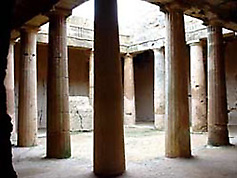 Ethnographical Museum- Private collection of objects from the Neolithic Age to the present day.
Ethnographical Museum- Private collection of objects from the Neolithic Age to the present day.
Tombs of The Kings - Wide area containing underground tombs carved out of solid rock dating to 4th century BC, many decorated with Doric pillars. Whether Kings were buried here or not, the magnificence of the tombs gave the area its name.
Ayia Solomoni Church- Originally a Christian catacomb. A sacred tree stands at the top, which, according to tradition, cures the disease of those who hang a personal offering on its branches.
The Mosaics Of Paphos - House of Dionysos, House of Theseus and the recently excavated House of Aion. The amazing mosaic floors, of these 3rd century AD noblemen's villas, are considered among the finest in the Eastern Mediterranean . They mostly depict scenes from Greek mythology and are beautifully executed.
Paphos Odeon - A small 2nd century Odeon entirely built of well-hewn limestone blocks. It was uncovered by the Cyprus Department of Antiquities in 1973-4 and is now regularly used for musical and theatrical performances.
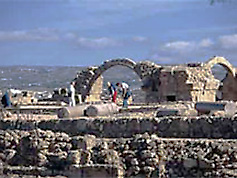 Saranta Kolones - Kato Paphos, near the harbour. This castle was built in the first years of the rule of the Lusignans (beginning of 12th century) maybe on the site of a previous Byzantine Castle.
Saranta Kolones - Kato Paphos, near the harbour. This castle was built in the first years of the rule of the Lusignans (beginning of 12th century) maybe on the site of a previous Byzantine Castle.
Paphos Castle- Kato Paphos. Originally built as a Byzantine fort to protect the harbour, it was rebuilt by the Lusignans in the 13th century, then dismantled by the Venetians in 1570, who were unable to defend it against the Ottomans, who in their turn, restored it after they captured the island.
Panayia Limeniotissa Basílica - Kato Paphos. Dating from the Early Christian period, probably early 5th century and dedicated to 'Our Lady of the Harbour'. It was almost completely destroyed during the 7th century Arab raids.
Panayia Chrysopolitissa Church And Byzantine Basilica - Kato Paphos. Built in the 13th century, over the ruins of the largest early Byzantine basilica on the island. Within the compound, one can see the so called St. Paul's Pillar where, according to tradition, Saint Paul was flogged at some time before the Roman Governor Sergius Paulus was converted to Christianity. Excavations are still underway.
Theoskepasti Church- Kato Paphos, facing the harbour. Theoskepasti means 'Veiled by God' and according to tradition, God sent down a fog to protect the original church during the Arab raids. The modern church was built in 1923.
Paphos Area
 Petra Tou Romiou (Birthplace of Aphrodite) - 25 km east of Paphos. According to legend, Aphrodite, goddess of love and beauty, rose from the waves in this strikingly beautiful spot. The Greek name, Petra tou Romiou (The Rock of the Greek), is associated with the legendary frontier-guard of Byzantine times, Dighenis Akritas, who kept the marauding Saracens at bay with amazing strength. It is said in one such fight he heaved a large rock (Petra) at his enemy.
Petra Tou Romiou (Birthplace of Aphrodite) - 25 km east of Paphos. According to legend, Aphrodite, goddess of love and beauty, rose from the waves in this strikingly beautiful spot. The Greek name, Petra tou Romiou (The Rock of the Greek), is associated with the legendary frontier-guard of Byzantine times, Dighenis Akritas, who kept the marauding Saracens at bay with amazing strength. It is said in one such fight he heaved a large rock (Petra) at his enemy.
Yeroskipou Folk Art Museum. The name of the village comes from the Greek word "Hieroskepos", the sacred Garden of Aphrodite. A fascinating collection of Cyprus folk arts and crafts is gathered together in the house known as Hadjismith.
Ayia Paraskevi Church- Yeroskipou village, 3 km east of Paphos. One of the most interesting and attractive Byzantine churches on the island, dating to the 10th century, with a vaulted basilica, a nave and two aisles surmounted by five domes, with later frescoes dating to the 15th century.
Temple Of Aphrodite- Kouklia village, 14 km east of Paphos. This is Palaepaphos, Old Paphos, one of the most celebrated places of pilgrimage of the ancient Greek world and once an ancient city kingdom of Cyprus. Here you will find the ruins of the famous Temple of Aphrodite. The most ancient remains date back to the 12th century B.C. The temple was one of the most important places of cult and pilgrimage of the ancient world until the 3rd-4th century A.D. The museum in the Lusignan Manor is small but impressive with many finds from the area. 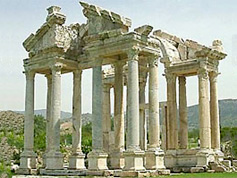 Panayia Chryseleousa – Located 3 km north of Paphos, Emba village and is a 12th century church standing in the centre of the village. A series of icons and two panels with the 12 Apostles date to the middle of the 16th century.
Panayia Chryseleousa – Located 3 km north of Paphos, Emba village and is a 12th century church standing in the centre of the village. A series of icons and two panels with the 12 Apostles date to the middle of the 16th century.
Peyia - Ayios Georghios Basilica and the picturesque fountains. Peyia village, 19 km north-west of Paphos boasts picturesque fountains which can be found in the beautiful stone-paved village square. 4.5 km from the village, near the fishing refuge, are the ruins of two early Christian basilicas with some interesting mosaic floors depicting animals. This site must have been an important establishment in early Christian times.
Ayios Neophytos Monastery – Located 9 km north of Paphos. It was founded in around 1200 by the Cypriot hermit and writer Neophytos. The Encleistra or enclosure carved out of the mountain by the hermit contains some of the finest Byzantine frescoes dating from the 12th to 15th century. In the monastery's church there is an interesting collection of icons and remains of 16th century frescoes.
Chrysoroyiatissa Monastery – Located 40 km north-east of Paphos. Turn right before Stroumbi village and you will find the monastry set in beautiful surroundings. It is dedicated to Our Lady of the Golden Pomegranate and was originally founded in the 12th century but the present building dates to 1770. An impressive religious ceremony and celebrations are held on 15th August. Recently the old winery of the monastery was reopened and produces some of the best vintage wine available in Cyprus. 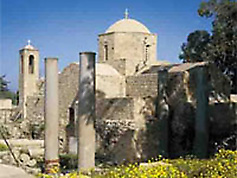 Pano Panayia - On the west of Troodos 1.5 km from Chrysoroyiatissa Monastery. It is the birthplace of President Makarios. The house where he was born has been turned in a museum.
Pano Panayia - On the west of Troodos 1.5 km from Chrysoroyiatissa Monastery. It is the birthplace of President Makarios. The house where he was born has been turned in a museum.
Polis (known in ancient times as Marion ) - 37 km north of Paphos, Polis is one of the ancient kingdoms of Cyprus. It became an important commercial centre in Classical and Hellenistic times and maintained close relations with Athens. Some beautiful houses, dating to the beginning of this century, can still be seen here. Polis, with its excellent climate along with beautiful beaches and scenery, is now developing into a popular resort.
Baths of Aphrodite (Akamas Peninsula, near Polis)- 48 km north of Paphos. This is an area of breathtaking beauty associated with Aphrodite. According to legend, the goddess Aphrodite used to bathe in the pool of the nearby natural grotto, which is shaded by a fig tree. A trail from the Baths takes you to Fontana Amorosa (8 km from the baths, at the end of the Akamas Peninsula). From this trail, you can enjoy and superb views and natural beauty.
Quick transfer time from Paphos airport (30 minutes) and Larnaca airport (90 minutes) makes it a popular destination for property purchasers and tourists alike. A resulting strong holiday rental market is an added advantage to those property investors in Paphos who wish to gain income from their property for all or part of the year.
Property Investment in Paphos
Growth figures for property in Paphos were at their peak between 1996 and 2002. During this time four out of five properties in Paphos were owned by non-Cypriots and the tourist infrastructure was well advanced with natural hillside beauty and a cultural heritage that outperformed all other towns on the island. As time went on new villages within the Paphos area emerged to cater for the growing numbers of people retiring and moving there to live permanently.
Today, Paphos properties are priced on average 20% to 30% higher than properties with similar characteristics in say, Protaras or Larnaca. This seems to have slowed down the demand for Paphos properties while other areas of Cyprus have become developed with comparable standards to Paphos, for a fraction of the price. This slowdown is seen as temporary as demand increases for the other locations and slowly drives prices in these regions up to a similar level.
Many investors were the first to make the geographical shift from Paphos since they predicted the slowing down of the market. This phenomenon is keeping prices constrained in Paphos and many investors argue that the market has now stabilized.
Current Conditions and Predictions
It is true the property industry in Paphos seems to lack the activity that it enjoyed over previous years and this is due to the higher prices here when compared to other similar locations in Cyprus. Demand is expected to increase again when prices in other towns reach similar levels to those in Paphos. Considering the current growth rates, this is expected to occur within the next two to three years.




